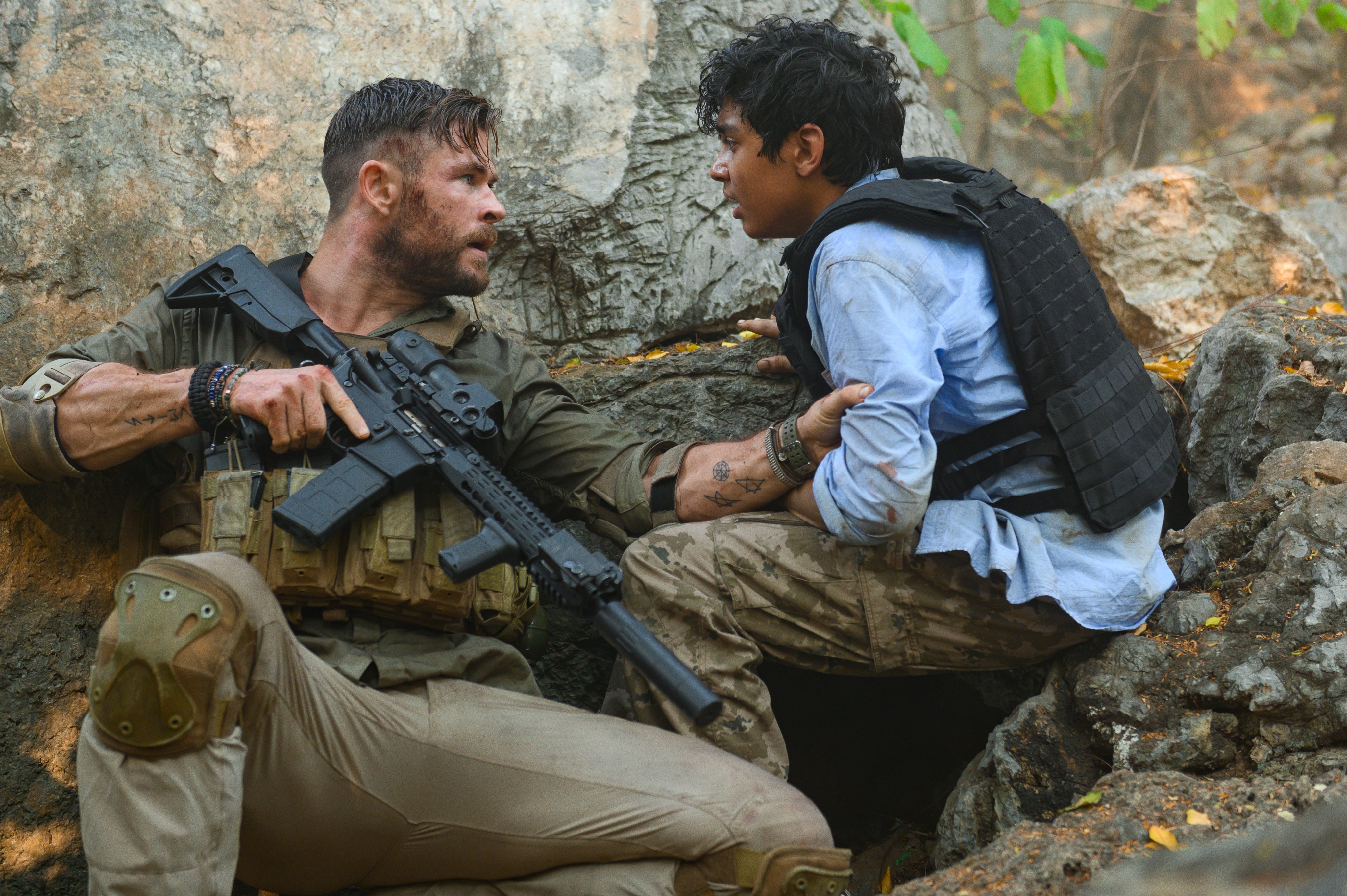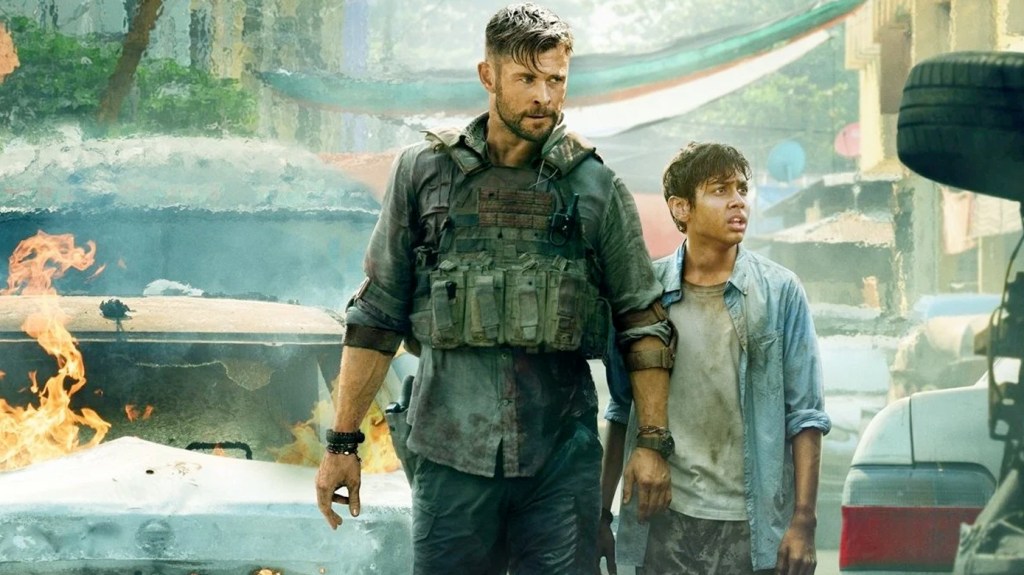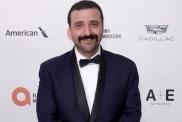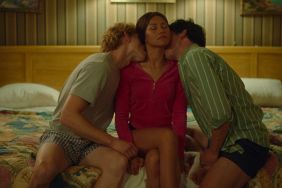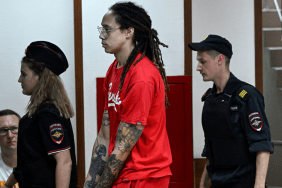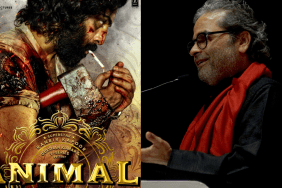If you’re looking for a film to watch this weekend then make sure to check out the Chris Hemsworth thriller Extraction, which debuts April 24 on Netflix. The film promises insane stunts, crazy action, and an intense performance from its star. We were lucky to talk to the film’s director, former stunt coordinator Sam Hargrave, making his directorial debut, who provided a deeper look into the wild production, including a crazy, lengthy one-shot action sequence that takes place in the middle of the film.
Extraction (formerly titled as Dhaka) takes place in an underworld of weapons dealers and traffickers and follows a young boy who becomes the pawn in a war between notorious drug lords. After being trapped by kidnappers inside one of the world’s most impenetrable cities, his rescue beckons the unparalleled skill of a mercenary named Tyler Rake. But Rake is a broken man with nothing to lose, harboring a death wish that makes an already deadly mission near impossible.
The cast includes Chris Hemsworth (Thor: Ragnarok), David Harbour (Stranger Things, Black Widow), Derek Luke (13 Reasons Why), Fay Masterson (Vice), Golshifteh Farahani (Paterson) and newcomer Rudhraksh Jaiswal. The film, written by Joe Russo, is produced by Netflix. Extraction is produced by Avengers: Endgame directors Anthony and Joe Russo through their AGBO banner along with Hemsworth, Mike Larocca, and Eric Gitter.
RELATED: Russos to Produce Hemsworth-Haddish Comedy Down Under Cover
ComingSoon.net: First of all, I just want to say congratulations on the film Extraction. I watched it last week with my wife. She had to cover her eyes quite a bit, but I enjoyed it. That was a kickass action movie.
Sam Hargrave: Oh, thanks!
CS: It played out like a stunt man’s dream come true, mainly that big action set piece in the middle of the film. How did you put that sequence together, because that was phenomenal?
Hargrave: Thank you, first of all. I’m glad you enjoyed it. I’m glad it was entertaining. Well, that took some thinking. It wasn’t written that way. Joe Russo wrote a great script that had a big action set piece written in the middle, but it was all cut up from different perspectives from Rake and from Saju’s perspective, from the police perspective. But then, when I was reading the script, I was reading huge, like a Borne chase or a Bond chase. And then, when we were getting into the nitty-gritty of time and money and I would continue reading that sequence, I was like, oh, this is going to be really difficult to pull off and do it justice to how it was written, because it was written big. And so I was like, how do we do this? Because when I read it, it read like, 10 days in main unit and three weeks of second unit. Like, and then we just didn’t have that in the cards.
So I was like, without doing it kind of half-heartedly and getting a sequence that you tried, a pat on the back, and we make it unique so that people kinda enjoy it. So we kinda went the opposite of like, let’s just make it a little more intimate, a little, I mean, I wouldn’t say less grand, but just a different perspective so that people can get into this moment with Tyler and Ovi and actually experience an extraction in real-time because it’s kind of the promise of the premise, the title of the movie, and you want to feel that and get to go along that journey with them. And so, as I started thinking of it, it started to come together. And it took some convincing. People weren’t off the top because it was more than easy. But once we decided to do it, the crew was all in and the logistics were insane, doing something like that in Aminabad, India, the amount of security to shut down streets.
You know, we had upwards of 200 to 300 people shutting down streets for us on certain days. We spanned over — it was the first 10 days of shooting, actually, because we jumped right in. There was no warmups. We just jumped right into the biggest, hardest sequence of the entire movie. But it was well-rehearsed and planned out and Hemsworth had been there rehearsing the action, so he was spot on with his performance and he would, after filming for one day of shooting, he’d go to the rehearsal space that night with the stunt team and rehearse the next day’s action. That guy was a machine.
CS: You filmed that scene in 10 days?
Hargrave: We did. It was 10 consecutive days and we’d probably knock off maybe, I don’t know, between three and six stitches, as we call it on the day because we wanted to do as much in a single take as we could. But there were just certain logistics of locations and wardrobe changes or wound applications or even vehicle technical changes, where he had to go from a rear-drive vehicle, where the stunt man’s in the back of the car to a pod car, so where he’s on top of the car. So certain things just made it impossible to do all as one. But we broke it up into manageable stitches, where we would digitally blend and in-camera kind of blend pieces together. And you know, we broke it out so it took place over 10 days, consecutive days, yeah.
CS: That’s insane. Hats off to you, because that was very, very, very impressive.
Hargrave: Thank you. Thank you very much.
CS: The action scene is phenomenal. So what was the most challenging aspect, would you say of that sequence? Because as you were saying, you guys were using handheld. You’re falling off of roofs. You’re jumping into cars. You’re jumping out of cars, into trucks, all that kind of stuff.
Hargrave: Yeah. I mean, I think it’s interesting because all the aspects were challenging. Every department was challenged, from special effects, picture vehicles, locations, hair, makeup, wardrobe, stunts. Everyone was challenged to the max, but they all met that challenge with a really awesome outlook and positive attitude. But so, any one particular thing, I don’t know. I think it’s just the overall logistics of pulling that together, and then the kind of being very, in a way, lucky, like of 10 days of kind of consistent weather, consistent everything kind of working.
We had a few bumps on the road, but that’s part of what the beauty of preparation is, is we had so well-rehearsed that everybody — I mean, we did probably seven or eight different tech scouts with the entire crew, just over and over again so the people knew where they needed to be, what was happening. And so, when it happened it was almost like we’d done this, but we’ve done this before. And we did. The stunt team, pretty much all of the action was shot previously by me with the stunt team and the doubles, just to make sure it all worked. Like we were kind of testing and proving because it’s tough to show up on the day and you’re like, you know what guys? This doesn’t work. So we tested it all ahead of time.
And then, well, I guess two things I’d say the most difficult that we’d overcome, like I said before, the location, like the logistics of keeping everybody safe, because that was my number one priority coming from an action background. And there’s so many people, so many children running around and cows and dogs. The environment is amazing and rich and colorful, but there’s just a lot of living beings moving around that have to be kind of accounted for and made safe while you’re doing these car chases through the streets. So that was just a lot of manpower and time to make sure that happened. And then, truthfully, and it doesn’t sound like you know this, but we did the entire sequence with rubber guns.
CS: Did you really?
Hargrave: Yes.
CS: See, now I’ve got to watch it again.
Hargrave: Yes, because we couldn’t — the lesson for that is it’s great for the country, but we couldn’t import weapons to India. And so, it was kind of a cost/benefit analysis. And the location gave us so much visually like it was so important to be there and to see that space and to move through it that we’re like, well, either we go somewhere else where we can have the guns, or we just make do with the rubber ones. And you know, the props department has amazing guns. I think the most amazing part is the performers adapting — because it’s not easy to make shooting rubber guns look real.
CS: Right.
Hargrave: You know, I don’t know how much interaction you’ve had with guns, but there’s a certain feel and a certain interaction you have with a gun when it’s actually firing. So when it’s not and you have to act that out, it’s very difficult. So everyone did an amazing job and I’m very proud of the sequence and how, you know, it all came together.
CS: Yeah, it looked great. I didn’t notice any of that stuff at all.
Hargrave: Good.
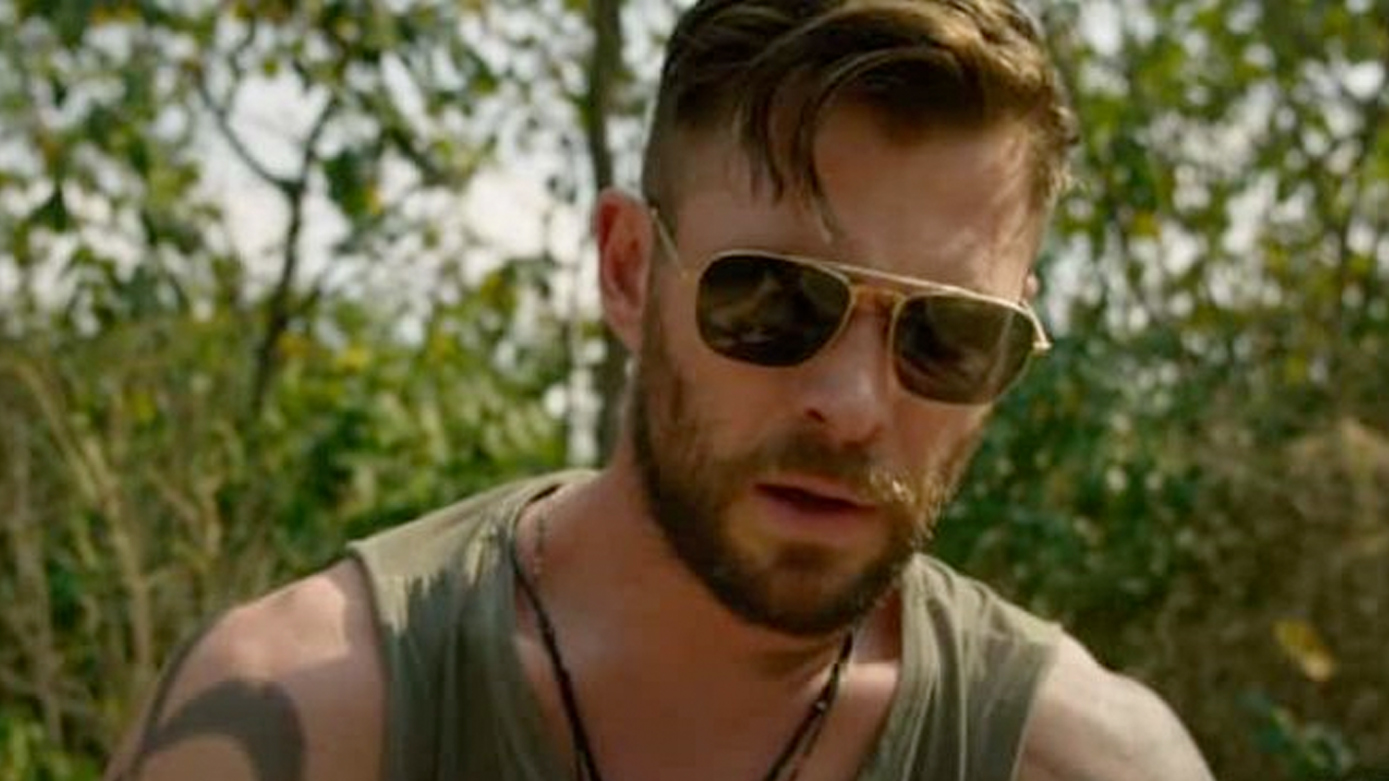
CS: Chris Hemsworth was a beast. He’s out there doing it. It seems like through most of those action scenes it was him on camera. How much of his own stunt work was he able to do? And then, at what point did you have to maybe pull him aside and say, okay, let the stunt team take over?
Hargrave: Yeah, well, Chris is amazing in many ways. Physically, he’s more capable than most actors I’ve worked with in my time, and his commitment to collaboration and putting in the work is unparalleled. But then, he also, he’s a smart guy. He knows filmmaking, so he would do anything that we thought was safe and that we needed his face for and that he wanted to do, but he also — it was never one of those where he’s like, oh come on, man. Let me try that dangerous thing. He and his stunt double, Bobby Holland Hunton, they’re a very great relationship, so he goes, “Yeah, Bobby, you’re up.” And with a smile, he would let Bobby make his character look good, you know? He understands what he needed to do, but also, what Bobby will do more safely or better. You know, Chris can’t risk twisting an ankle or bashing up his face because then the movie shuts down. He’s very aware of that, so he’s awesome to work with from a stunt perspective. But it was, I would say 95, almost 98 percent of that entire sequence was Chris Hemsworth.
CS: Wow.
Hargrave: You know, for example, we didn’t hit our star with a car. We put Bobby into that. But in the vehicles, like those cars are flying, sliding around and everything, that was Hemsworth who was in there. That wasn’t a digital face replacement, it wasn’t doubles. That was Chris.
CS: And how much easier does that make your job? Because now you can put the camera anywhere you want, right?
Hargrave: Oh yeah, it’s night and day. Like if we didn’t have somebody like Chris — truthfully, part of my thought process having seen some of his rehearsals and worked with him in the past on the Avengers movies is knowing his abilities. I was like, hey, he, of a very short list of actors could pull off a sequence like this. And I wouldn’t probably have tried such a thing if I didn’t know his capabilities. So it allowed me to put the camera where I think where audiences want to see it. You want to be back a little bit, kind of what Chad Stahelski and David Leitch have done with the “John Wick” movies, right, is like see the actors doing these impressive martial arts feats. And so, we were able to do that with Hemsworth. We follow him through some stuff where, you know, most of the time you’d have to cut or go over the shoulder of a double, we just hung right in there with Chris and he did it.
CS: That’s awesome. Okay, so you worked as a stunt coordinator for most of your career. What made you decide to jump into the director’s chair for this movie? Was it the movie itself? Was it just the concept or was it just a longing of something that you’ve wanted to do for a while?
Hargrave: That’s a combination of both things. I’ve wanted to direct for a long time. I started out making short films with my brother and sister when I was like, 10 years old, like little Westerns in the backyard. And I went to, got into martial arts, martial arts movies, started making videos with my friends, went to film school. And so, writing and directing and making films, telling stories was always something that I was going to do. It was like, oh, I’d love to do this someday. It’s like, I’m going to do it. It’s just right now, I’m really enjoying the action side of things and meeting people and learning my craft. And it’s just kind of biding my time while looking for the right story and letting people know that this is something I want to do. Because sometimes, in Hollywood, you get pigeonholed and it’s hard to break out of that category people put you, in you know?
So but that’s my desire came from wanting to direct and to tell stories. But then on the other side, the opportunity side is the Russo brothers, Joe and Anthony, without them, obviously it wouldn’t have happened. Joe wrote a great script and I actually read it probably six or seven years ago, when it was called “Ciudad”. And I think Chad Stahelski was attached to direct it at one point or was circling it, and it was a very, very different thing. And I read it and loved the story then. And then, it went away. I did a lot of stuff with the Russos and kind of got close with them. They gave me a lot more responsibility around like, you can direct on the biggest movie of all time, Endgame. And during those processes, it was actually Infinity War where the conversations started in earnest.
On Civil War, I had mentioned I believe that I wanted to direct, and their reaction was very much a Russo reaction. It was kind of nods and keep it close to the chest. But once we got to Infinity War and I was doing more second unit and they’d seen some of the footage coming in and we had a lot more discussions because we were very in-depth about the story and character and whatnot, Joe posed the question, he said, “I’ve got a script that I think you would be perfect for to direct. Do you want to give it a read?” I said, “I would love to. Thank you very much.” And when I read it, it was called “DACA” and I was like, wait this seems so familiar. And then it all kind of came together. It was previously “Ciudad” and then it was “DACA” and then we changed it to Extraction. But once I read it and I had a few comments, a few little tweaks and changes that I wanted to implement and I gave him my notes. And again, Joe is such a collaborative and open filmmaker, he’s always the best idea wins. So we discussed it and made a few changes that I wanted to implement.
He was open to them and we did, and then I was like, “I’d love to do this picture.” And he’s like, “Yep, you’re the guy.” So once we started looking for an actor, it’s actually interesting how Hemsworth came about because we were looking for a very different archetype originally. We were trying to go for something a little less, I don’t want to say less obvious than the god of thunder, but a little more every day, a little more mundane so that when the action would break out, you’d be like, oh. It’d be a little more surprising. But then, so we had our minds set in one direction. But then, when Hemsworth — I don’t know if Joe posed it to him or he heard us talking or something. When he got involved or showed interest, we both kind of looked at each other and were like, hmm, that’s kind of a no-brainer. He can handle the action. He’s got star power. He’s a great guy to work with and he actually fits the written character.
We were trying to kinda change what was on the page, but the written character’s a big guy who can take a lot of punishment, and we’re like, hmmm, kind of checks all the boxes. So and then, once he said yes and I was directing and Joe would be writing and producing, when Netflix jumped on board, they were like, yeah, we’ll do a Chris Hemsworth action movie. We did it.
CS: I just wanted to ask you, as a director, what were some of the things that you learned about your style on this film that you would probably implement moving forward, as a director?
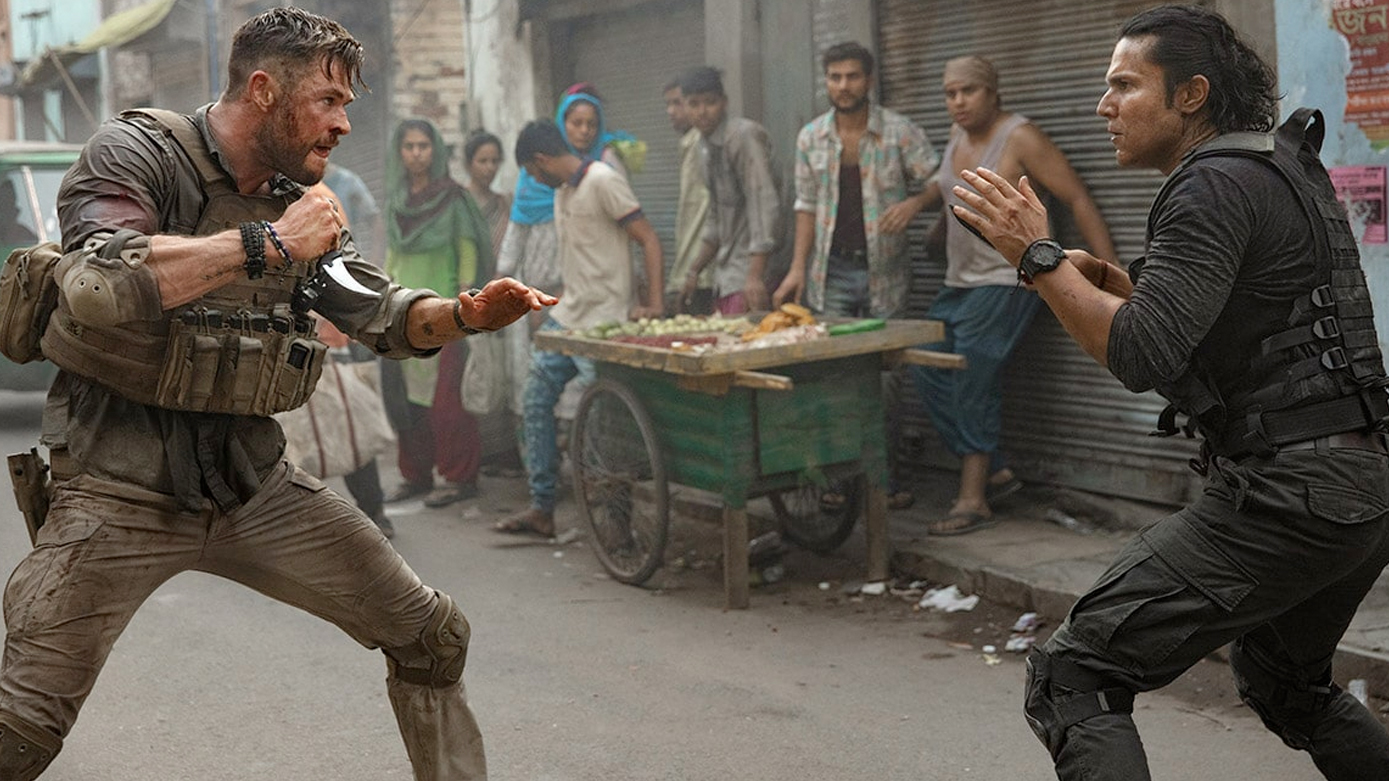
Hargrave: Oh interesting. Good question. Well, it’s funny. Going in, my focus was, I was drawn to the script and I’m drawn to stories — wait, I think most people are — but like, a primal need for the characters or a primal relatability. And redemption, making up for mistakes in the past I think is one of those, and helping people in need. But so, drawn to that. So my focus was very much on the character relationships and the emotion and whatnot, because I felt like, oh, I’d done a lot of action and that was going to not — I’m not saying something I had to worry about, but it would kind of come a little more naturally. And then, Chris Hemsworth said something to me that stuck was, he’s like hey, I’ve done a couple of these with first-timers and just don’t forget why you got the opportunity. Which I’m not saying don’t focus on story and characters, but don’t forget your bread and butter. Don’t forget where you came from, which is action. So don’t spend so much time trying to focus on the thing that you want to impress other people with, that you forget why people enjoy you and your work.
And so, that was something that stuck with me. And so, I was like, you’re right. So I made sure to pay — not fluff off the action or not give it the attention it deserved. And I think that shows. But I think discovering a style that a lot of these things I feel like sometimes smaller is more efficient. And I learned that or kinda was reiterated when you’d be on main unit and it’s just the nature of the business, where when you have the stars, just the size of things grows. And then, sometimes you go like, oh, it’d be nice to have all of these things. And it’s just like, oh, we need this. You think bigger is better. And you get 10, 15 setups in the day. Then I go over to second unit, and you’d knock off 40 to 50 setups a day. And I’d go, hmm, hold on a second. And Chris would be with us and we’d just be moving quickly and having fun. And the only difference was kind of the amount of stuff that was there because it just adds up. To do a turnaround, when you have lots of stuff, like gear and lots of people it just takes longer because you’ve got to move all that stuff.
And so, it’s interesting. I kind of like or as a style, as a working style I guess, I kind of lean in smaller and lean in efficient. And that was just kind of something that really was solidified for me on that. Every style has its place. There’s a time and a place if you’ve got to have all the gear and all the things for certain setups and shots. But in general, I kind of prefer the lean, mean, down and dirty style of filmmaking.
CS: Well, my final question, because I know you’re a busy guy and I don’t want to take up too much of your time, and you’ve been very generous, by the way, and I really appreciate it.
Hargrave: Well, hey, I appreciate it. You’re easy to talk to. Thanks, I appreciate it.
CS: How much more freedom does a company like Netflix afford? Because there’s a lot of elements in this film, like with the kids being hurt and thrown off roofs at one point that you don’t typically see in a big-budget film these days.
Hargrave: Yeah, well, I think the beauty of Netflix is they’re making the movies that studios don’t make anymore, which is the midrange, mid to upper range budget action movies because in the theatrical world at least these days, or when we were making that movie, for that price point, that movie doesn’t get made. It’s too big of a risk, which is a shame because a lot of my favorite movies, if they were being made today, would not have been theatrical releases. But I think that’s the beautiful thing. I’m glad Netflix is there so that those kinds of films have that space to be seen because it’s either, it seems like it’s either a $200 million Blockbuster superhero movie in the theaters or the small $5 to $10 million indie that if it lands big, is going to be a big profit. So those middle-range movies are having a harder time, and Netflix kind of gives you that outlet.
And then, I’d never had to deal with other studios from a directing standpoint, so this is my first one. But from what I’ve heard, and other people I’ve talked to and worked with, my experience with Netflix is they were extremely supportive and very hands-off in the filmmaking process. They weren’t down there telling you what to shoot, telling you how to do it, or nagging at all. But they were a phone call away if you needed support. So it really, for me, was a very nurturing, kind of helpful environment because I was free to make the movie that I wanted to make with Joe Russo providing oversight and helping shepherd me through a lot of it. But the Netflix side of it, it wasn’t kind of the horror stories you hear about studio execs and the studio representatives just being right behind you and the monitor being like, hey, do this, do that, you’ve got to do this. It was not that way at all. They were nothing but supportive, which I think allowed me to try things that like you said, you wouldn’t normally get to put in a movie like this because somebody would just squash it.
CS: Right, right. And like you said, it is cool that we are getting almost a resurgence of that edgier style of film. And what’s next on your docket? As a director, any plans to do any Marvel films in the future, anything like that?
Hargrave: I’m open. The future is, for me, wide open and I’m open to, I’d be happy to discuss doing bigger budget movies with Marvel if that’s something that fits for them and for me. It’s all got to be the right creative decisions for both sides and kind of right personal decision and business decision because it’s show business. And so, you want to make sure that they’re getting what they need and I’m kind of getting what I want. I would love to expand and try a different genre, try something different. But there’s nothing on the horizon at the moment. I’m just kind of hunkered down here at the moment with the state of the world and doing a lot of writing and just making sure that all of the steps that need to be taken to get the world Extraction so they can all enjoy it, that’s my focus at the moment. And then, I’ll talk with the team and try to narrow down what the next step’s going to be. But it’s very exciting. I’m really looking forward to, if people watch the movie and if they like it and if I get another chance to direct it, I can implement a lot of the lessons I learned while making Extraction and hopefully improve as a director on the next one.
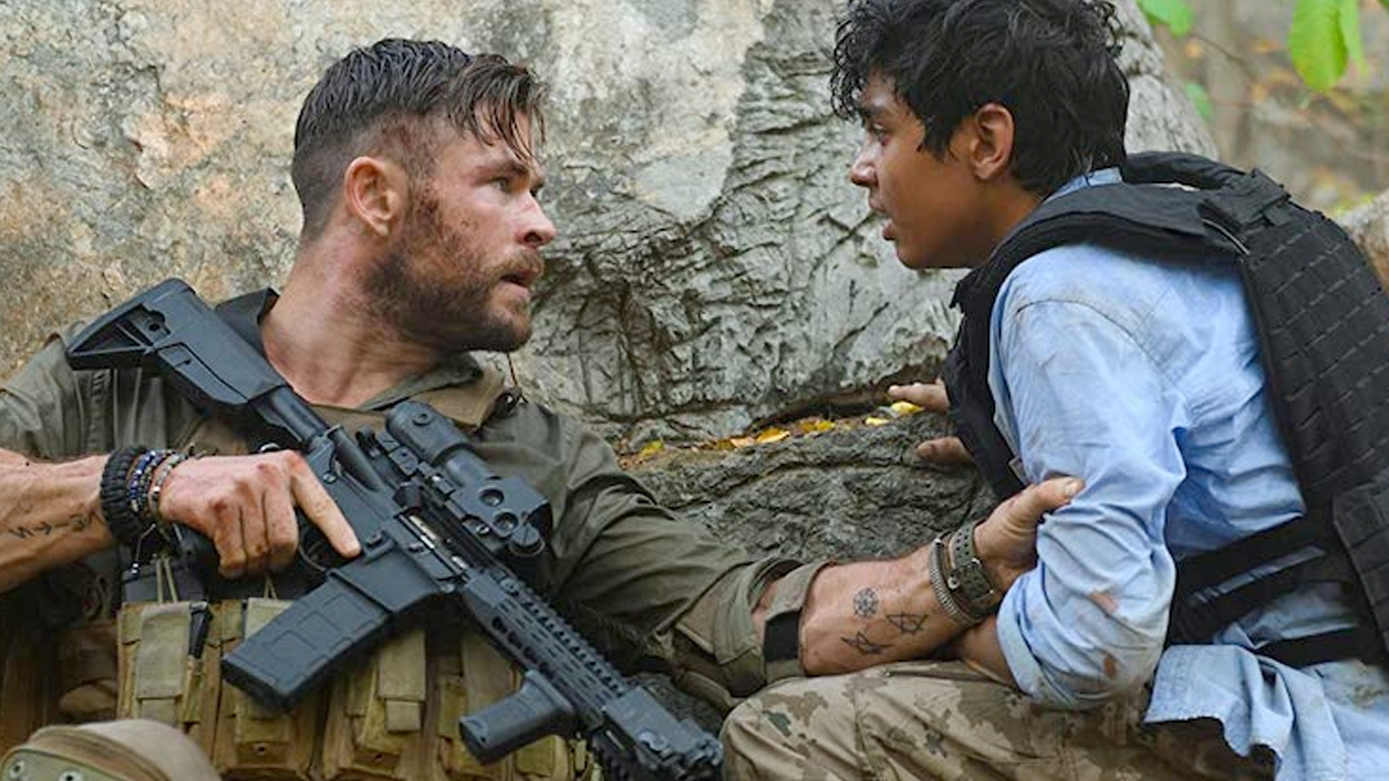
[WARNING: SPOILERS — Hargrave discusses the end of the film]
CS: So I have to ask then, and I’ll issue a spoiler warning before, if we post this question, you leave the audience with a very ambiguous ending obviously as to whether or not he’s alive or dead. In your mind, is Tyler Rake an action character you’d like to see more of in sequels? Have you guys considered that at all or do you consider his story complete?
Hargrave: You know, that’s a very interesting question and one that we’ve gone back and forth with a lot. And you know, I’ll just be truthful. Meg, you can stop me if I put my foot in my mouth. Or you can use your — but the original story that I wanted to tell, that we all wanted to tell, but I’ll just do it from my perspective. The original story I wanted to tell was one story and that was it, Tyler Rake sacrificed himself to save the kids and that was it. We were done. It was a redemption story in my eyes, and his journey was complete by the end, that he had found purpose and found peace with his past and that was his story. But then, as much fun as everyone was having shooting this movie and as great a job as Hemsworth did with the character, the potential of this character coming back and seeing more of his stories became very enticing to everyone. And it was truthfully, it was a very strong back and forth. There was a strong camp that was like, no, he should make it. And another camp was like, no, he has to make it.
And then so, which kind of leaves us with the ending that you have, is like, because we didn’t want people to feel that it was just a sequel for the sake of a sequel, which oftentimes happens in Hollywood. But we also didn’t want to have these people completely crush that he was never coming back. And we did a lot of testing and a lot of asking questions. And it seems like the ambiguity, the beauty of that is it allows people to come to their own conclusions and feel their own feelings at the end of the story. And if you like Tyler Rake and you want to see him come back, then you will see that image as him alive. And if you feel like he completed his journey and his redemption is fulfilled, you will be like, nah, that’s a mirage. So it was a deliberate choice, once we got in there, to leave it in that fashion.
CS: Personally, I want more Tyler. Just putting that out there.
Hargrave: Yeah, so then he’s alive. [laughs]
CS: Well, congratulations on the success of the film. It’s a nice throwback to those old 80’s actioners of old. And it’s the kind of film that like you said, we just don’t see anymore, so thanks for making it and I had a lot of fun with it.
Hargrave: Well, thank you very much for your time. I appreciate it. I’m glad you enjoyed the film.
Extraction
-
Extraction

-
Extraction
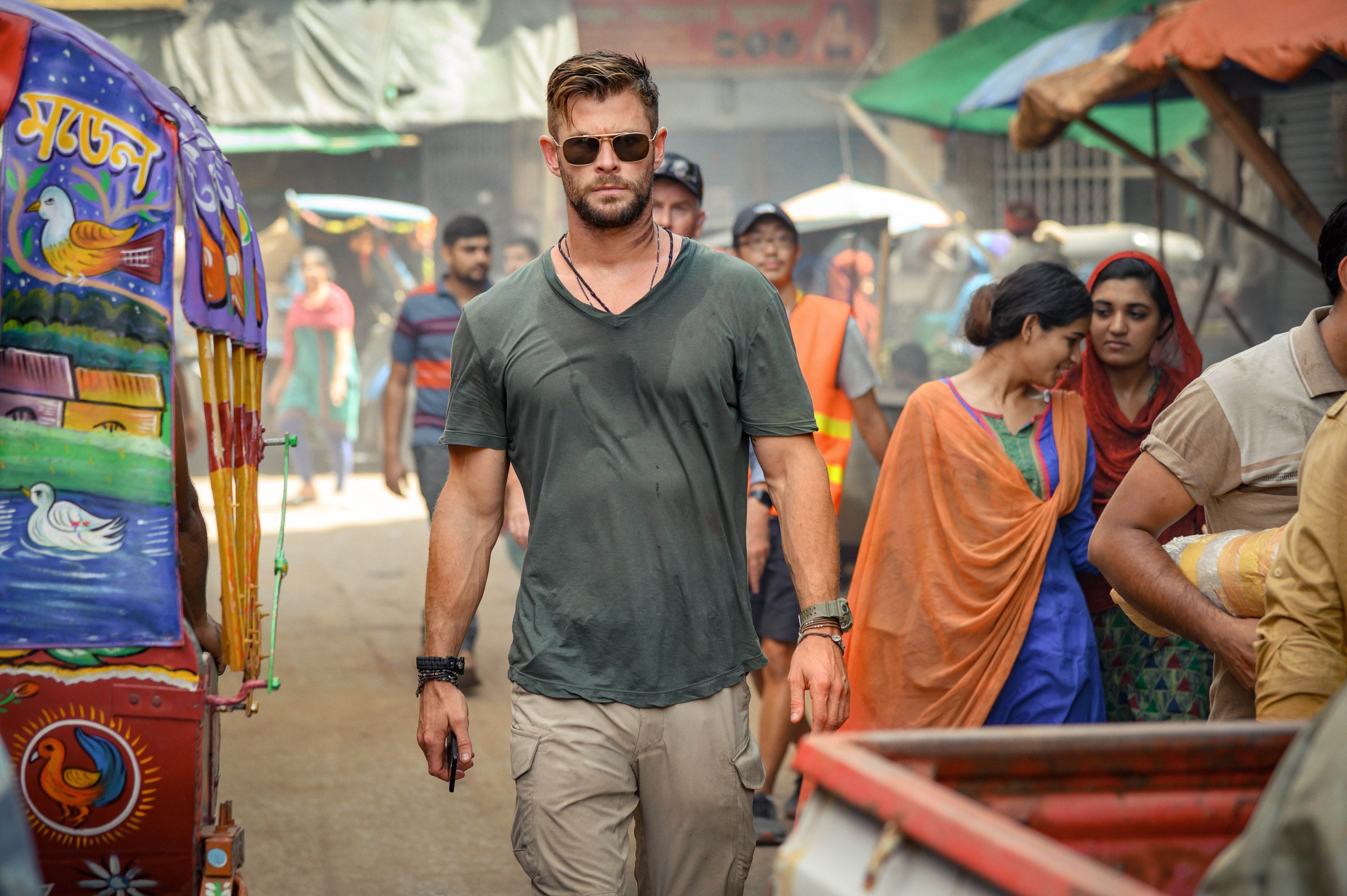
-
Extraction
